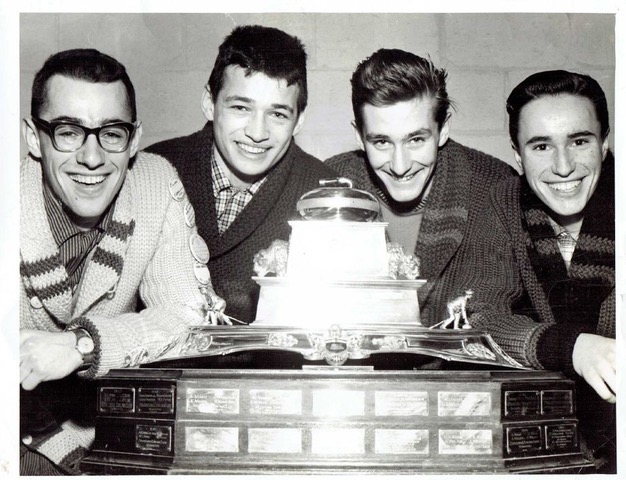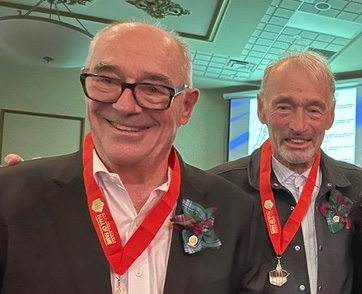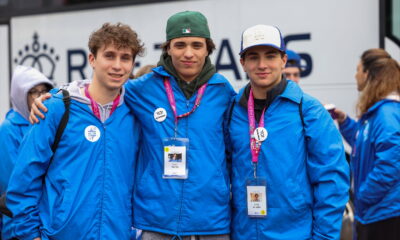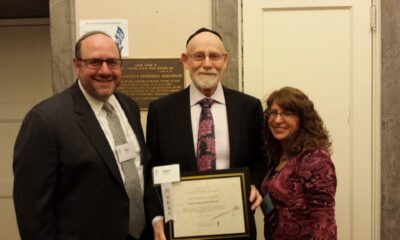Features
“Braunsteins on the broom” revisited

By GERRY POSNER Step back in time to 1958. It’s February and the Manitoba Curing Championships are starting in Winnipeg for the right to play in the McDonald Brier. Who should be competing but two Jewish boys from the south end of Winnipeg, Terry and Ron Braunstein? Terry was all of 18 while Ron was only 17. Also on the team were Ray Turnbull and Jack Van Hellemond.
The team competing for the Manitoba championship was skipped by Marno Frederickson. Although few expected the youngsters to have gotten this far, there they were in the final and, ultimately, they prevailed. As Manitoba champs they were entitled to compete in Victoria, BC in March of that year in the McDonald Brier.
Now, just getting to participate in the Manitoba playdowns was by itself a bit of good fortune. First, It was only because Terry came home from school in Texas where he was on a track scholarship in Houston that allowed him even to be around, available, and ready to play. Events in Texas had soured him on the University of Houston and that was exacerbated by his asking a black athlete, a running star, for some running tips. The coaches disapproved of that interaction, told Terry so warned him not to do it again. That – plus other factors led Terry to abandon the track programme.
So, Terry packed up, came home to Winnipeg and was out of school for that year as a result. But he had time to curl and the Maple Leaf rink as well as the Granite Club were inviting. It did not hurt that the uncle of the Braunstein boys was Eph Portigal, a mover and shaker at the Maple Leaf Club. In fact, Terry has always made clear, as did Ron, that their uncle Eph was instrumental in teaching the boys some curling strategy, a significant part of every curling game.
To be clear, the boys had curled some before as they grew up for a chunk of their early years in Binscarth, Manitoba where their father, Dr. David Braunstein was a physician.The boys, as they were then, had (and always have had) what might be called some serious athletic genes. Anyone who can remember Dr. Dave will recall that, among his many abilities in sports, he was a fastball star.
That the athletic gene was prominent in the Braunsteins became evident to me long ago. I recall the day when I first came across the Braunstein brothers and was in awe of what they could do athletically. It was about 1955 and the Braunstein family had moved to Winnipeg. They were living temporarily with the Portigals on Wellington Crescent – near my home on Cordova Street. Up until that time, I fancied myself as a bit of an athlete. Then I met Ron and Terry Braunstein. I saw them playing baseball on Wellington Crescent so easily and smoothly as if they were born with a glove in utero. Right then and there, at age 12, I realized, just how lousy I really was. I have always commented that, of the people I knew personally, the Braunsteins were the best athletes I had ever seen to that point. Of course, in truth, the range of my relationships at that time was slender, so they had few to compete with on my radar screen.
Now, the story of even getting to compete for the Manitoba Curling Championships was more complicated as the team had their lead drop out at the last minute. The rest of the team needed a replacement and had about 24 hours to submit a new name or they would not be allowed to enter. Terry remembered playing against a young kid earlier who had impressed him, but didn’t know how to reach him. “Him” was Jack Van Hellemond, not yet 16. Terry thought that Jack curled at the Belgian Club so he went there that night and luckily found Jack, invited him to play on his team. Jack agreed, but Terry still had to get consent from Jack’s parents and the principal at his school. All of that happened in less than 24 hours.
In any event, the boys did get in, with Ray Turnbull as second, Ron as third and Terry as skip. Not for a second did any of them think they would win the Manitoba Curling Championship event. In the end though, they were victorious at the Winnipeg Arena. I was there and that is a memory etched in my mind.
Off to Victoria in March of 1958 they went and again, nobody thought they had a real chance of winning the Brier. Yet, they played so well that at the end of the week, their team ended in a tie with one of the legends of the game, Alberta’s Matt Baldwin. That forced a sudden death championship, winner take all. I recall sitting close to my radio following every shot as the game progressed. I was crestfallen when they lost in a very tight match. But, as a sports writer then for the Kelvin High School Et Cetera newspaper, as it was then called, I had the chance to write a column for the paper which had the headline “ Braunsteins on the Broom.” It was my first real writing experience that led to the publication of an article about the trip to the Brier for the Braunstein rink. Terry had graduated from Kelvin while Ron was still a student there. I thank Ron and Terry for the part they played, even if was inadvertent, in my budding writing career. This article just revisits that time and place.
The entry of the young Braunsteins into what was then the main event in the world of curling in 1958 caused a major change in the rules of the Canadian Curling Association. That a team with two 18-year-olds, as in Terry and Ray, a 17-year-old in Ron, and the 16-year-old Jack, could compete with adult men was too much for the veterans of the game, so a separate junior competition was created, which exists to this day. Thank the Braunsteins for that rule change.
And yet, that defeat in 1958 did not deter the Braunstein brothers at all as they continued to compete for many more years, ultimately winning Manitoba again in 1965 and going once more to the Brier, this time in Saskatoon. They had an almost unblemished record and won the Canadian championship with a team consisting of Terry as skip, the very well known Don Duguid as third, Ron at second and Ray Turnbull as lead. That was a big day for the boys, the Granite Curling Club and indeed Jews all over the Province of Manitoba who shared the moment vicariously with the Braunsteins. Unfortunately, the team lost in the World Championship in Scotland to a USA team skipped by Bud Somerville. That Ron had to bow out of the event owing to his medial school obligations might have been the factor that caused that loss. We will never know. What we can suggest however, is the fact that the USA win jump started the game in the USA, eventually createing an impetus to get Curling recognized officially as a sport in the 1998 Winter Olympics. Thank the Braunsteins (even in defeat) for that contribution.
The Braunsteins also changed the game slightly when they adopted a more finesse style rather than the hitting game so prevalent until that time. Maybe that change allowed the team to be so dominant. Whatever the reason, what is certain is that when Terry Braunstein won the Canadian Curling Championship in 1965 he was then the youngest skip to win it at age 25, also the first Jewish skip to win. My best guess is that brother Ron Braunstein was the first Jew to win as a second. Prove me wrong.
Even after 1965, Terry continued to be a major player in Manitoba for many years in the curling community. He had to play without Ron, as Ron had continued his medical career and ended up, after a stint in L.A., moving to Vancouver. Terry participated in 14 Manitoba Provincial Championships. He won three car bonspiels and several cash bonspiels, as well as the Grand Aggregate for most victories in the Provincial play downs in 1969, 1971 and 1977. And there were other honours bestowed upon him throughout his carer, including an induction into the Manitoba Sports Hall of Fame, an honour given later to Ron in 2013. Even as a senior Terry Braunstein excelled, competing in several Provincial Championships. In 1994 and 1995 his rink won the Manitoba Seniors’ Championionship. He even participated in the Master’s competition in 2006.
Now, curling was far from the only sport the brothers starred in, as baseball was at least as great a passion for them – and they played at a high level. They loved baseball as they were raised on it by their father. Moreover, both Ron and Terry became very good golfers ( though Ron was quite clear that he was never in Terry’s league). Of course, during all this time, both brothers had careers in which they were involved for a long time. Ron was a prominent psychiatrist in Vancouver, working in a Vancouver hospital for most of his career in the outpatient child and adolescent department. During his career he was significantly committed to the training of young psychiatrists. Given that there is so much thinking in the world of curling, I suggest that it is not such a long stretch from curling to psychiatry. That suggestion would need input from Ron and others who have had two kinds of careers. Save that thought for another article.

Ron only recently retired after over 50 years of medical practice. He and his first wife, the lated Sue Harris, had three children, all of whom live in the Vancouver area. And to nobody’s surprise, the kids are seriously athletic. The eldest, Jon Braunstein, was, and is still a serious runner, as in marathons. Daughter Amy played competitive soccer in British Columbia. Son Dave, the youngest, competes regularly in Ultima. Some genes never change.
As for Terry, he was the founder and head honcho for Danli Promotions, a specialty advertising firm in Winnipeg and beyond. Danli, of course was named for son Danny and daughter Lisa, the children of Terry and his wife, the former Andrea Greenberg. Danny ultimately joined him in the business and is still active in the promotional industry to this day. My son Ari tells me that Danny is a star on the Squash court.
The Braunsteins have achieved much in sport, particularly curling. But if you talked to both of the brothers, you would know little of their accomplishments, as they remain very humble about what they did. That too is a Braunstein gene. They may be quiet about it. I am not.
Features
Three generations of Wernicks all chose to become rabbis

By GERRY POSNER Recently I was at a Shabbat service at Beth Tzedec Synagogue in Toronto and the day unfolded in some unexpected ways for me.
It began when I was asked to be a Gabbai for the service, that is to stand up at the table where the Torah is placed and to check the Torah reading to make sure there are no errors. I have done this before and it has always gone smoothly. I attribute that fact in large part to the Torah reading ability of the reader at Beth Synagogue. He is fast, fluent and flawless. Well, on this particular day after he had completed the first two portions, he began the shlishi or third aliyah. I could not find his reading anywhere. It was as if he had started somewhere fresh, but not where he was supposed to be. I looked at the other Gabbai and he did not seem to recognize what had happened either. So, I let it go. I had no idea where the Torah reader was. He then did another and still I was lost. He came to what was the 6th aliyah when a clergy member walked over to him and indicated to him that he had read the fourth and fifth aliyah, but that he had missed the third one. The Torah reader then said to me “this is what you are here for.” Now, it might have been one thing if I had missed it entirely. Alas, I saw the error, but let it go as I deferred to the Torah reader since he never makes a mistake. He ended up going back to do the third aliyah before continuing on. This was a very unusual event in the synagogue. I felt responsible in large part for this gaffe. A lesson learned.
The feeling of embarrassment was compounded by the fact that on this particular day the service was highlighted, at least for me, because of the rabbi delivering the sermon. This rabbi, Eugene Wernick, was none other than the father of my present rabbi, Steven Wernick of Beth Tzedec Synagogue. He was also the same rabbi who was the rabbi at Shaarey Zedek between 1979-1986 and who had officiated at my father’s funeral in 1981, also a few years later at my oldest son’s Bar Mitzvah in Winnipeg in 1984. As I listened to him speak, I was taken back to the 1980s, when Rabbi Gene was in the pulpit at Shaarey Zedek. Of course, he is older now than in his Shaarey Zedek days, but the power of his voice was unchanged. If anything, it’s even stronger. As in the past, his message was relevant to all of us and resonated well. Listening to him was a treat for me. Still, my regret in not calling out the mistake from the Torah reading was compounded by the fact that I messed up in front of my former rabbi, Eugene Wernick – never mind my present rabbi, Steven Werinck.
On this Shabbat morning, aside from all the other people present, there were not only the two Rabbis Wernick, but one Michelle Wernick was also there. Michelle, daughter of Rabbi Steven Wernick, is a first year student at the Jewish Theological Seminary. She is following in the family business – much like with the Rose rabbinical family in Winnipeg.
As it turned out, there was a Bat Mitzvah that day. And the Bat Mitzvah family had a very real Winnipeg connection as in the former Leah Potash, mother of the Bat Mitzvah girl, Emmie Bank and the daughter of Reuben and Gail Potash (Thau). It occurred to me that there might be a few Winnipeg people in the crowd. As I scanned the first few rows, I was not disappointed. Sitting there was none other than Chana Thau and her husband Michael Eleff. I managed to have a chat with Chana (even during the Musaf service). In the row right behind Chana and Michael was a face I had not seen in close to sixty years. I refer to Allan Berkal, the eldest son of the former rabbi and chazan at Shaarey Zedek, Louis Berkal. I still remember the first time I met Allan at Hebrew School in 1954 when his family moved to Winnipeg from Grand Forks, North Dakota. That was many maftirs ago. So this was another highlight moment for me.
Of course, there are other Winnipeggers who attend Beth Tzedec most Shabbats. I speak of Morley Goldberg and his wife, the former Marcia Billinkoff Schnoor. As well, Bernie Rubenstein and his wife, the former Sheila Levene were also present for this particular Shabbat. In all, this Shabbat had a particularly Winnipeg flavour to it. Truth be told, you do not have to go far in Toronto at any synagogue and the Winnipeg connections emerge.
Features
In Britain Too, Jews Are in Trouble

By HENRY SREBRNIK Antisemitic attacks in Britain have surged to levels unseen in decades, with Jewish schools under guard and synagogues routinely targeted. Jews suffered the highest rate of religious hate crimes in the year ending March 2025, according to interior ministry data. And it has only become worse.
Jewish Post and News readers know, of course, about the attack on Jewish worshippers at the Heaton Park Synagogue in Manchester at Yom Kippur services on October 2, 2025. The attack killed Adrian Daulby, 53, and Melvin Cravitz, 66, and left three others injured.
Greater Manchester Police Chief Sir Stephen Watson said fear within the Jewish community had risen sharply, with even young children asking for armed police protection to simply attend Hanukkah parties.
While the blame for the violence lies with the assailant, an immigrant from Syria, who was shot dead by police, the responsibility for the circumstances in which two Jews died and where a Jewish community that has contributed loyally to British society for centuries fears for its existence lies with the leaders of the British establishment.
The Labour government, many of whose supporters and elected representatives flirt with pro-Hamas positions, has fueled the flames with its denunciations of Israel’s war and recognition of a Palestinian state. Many younger people, their minds filled with postmodern “anticolonialist” left ideology, are eager recruits to the cause.
Ruth Deech is a British academic, bioethicist and politician who sits in the House of Lords. Ten years ago, she warned that some of the country’s top universities had become “no-go zones” for Jewish students. But, in the wake of the October 7 atrocities and ensuing war in Gaza, she believes the situation is much worse.
“The warfare on the streets is being continued in the universities,” Deech told the Times of Israel Dec. 25. “The universities on the whole are not facing up to it, and the University of London campuses are probably amongst the worst. None of the vice chancellors seem to be able to summon up the courage to deal with it,” Deech contends.
“They take refuge behind freedom of speech, without realizing that freedom of speech stops where hate language begins.” Deech is highly critical of Oxford, where she has spent much of her academic life. British universities must take stronger action to protect Jewish students and use every tool available to confront hate and division.
But the reaction by authorities has generally been one of appeasement. For years, police refused to enforce hate-crime laws. Universities tolerated mobs chanting for Israel’s destruction. Politicians equivocated in the name of “balance.”
For instance, in Birmingham, the West Midlands Police, which cover the city, classified as “high risk” a soccer match between Maccabi Tel Aviv and Aston Villa on Nov. 6. The police cited “safety” as the reason for banishing fans of the Tel Aviv team, which now seems to be standard when unjustified bans are put in place.
As the Jewish Leadership Council noted on X, “It is perverse that away fans should be banned from a football match because West Midlands Police can’t guarantee their safety.” Prior to the event, masked men hung “Zios Not Welcome” signs in the windows of shops or restaurants. “Zio,” of course, is a not-so-coded word for Israelis and/or Jews.
Over the past two years, the Board of Deputies of British Jews, the country’s main representative body for the Jewish community, has faced questions of their own about how to conduct debates on Israel. Last April, 36 of the board’s members signed an open letter, which was published in the Financial Times, protesting against “this most extremist of Israeli governments” and its failure to free the hostages held since October 7. “Israel’s soul is being ripped out and we fear for the future of the Israel we love,” the letter read.
Five members of the Board were suspended for instigating the letter. The Board’s Constitution Committee found that they had broken a code of conduct by creating the “misleading impression that this was an official document of the Board as a whole.” But for some, the letter represented a watershed moment where some of the conversations about Israel happening in private within the Jewish community could be had in public.
Board President Phil Rosenberg argued that there has long been healthy debate among the 300 deputies. His primary concern is the safety of British Jews but also how the community sees itself. “We have a whole range of activities to confront antisemitism,” he maintained. “But we also believe that the community needs not just to be seeing itself, and to be seen, through the prism of pain.
“It already wasn’t right that the only public commemoration of Jewish life in this country is Holocaust Memorial Day. And the only compulsory education is Holocaust education. Both of these things are incredibly important, but that’s not the whole experience of Jews.”
Given all this, a new political party divide is emerging among British Jews, with support rising fast for the left-wing Greens, now led by Zack Polanski, who is Jewish, and buoyed by younger and “anti-Zionist” Jews, while the older Orthodox turn to Nigel Farage’s upstart right wing Reform UK, as trust in the two main parties collapses.
Support for Labour and the Conservatives among British Jews had fallen to 58 per cent by July 2025 from nearly 84 per cent in 2020, according to a November 2025 report from the Institute of Jewish Policy Research (JPR), entitled “The End of Two-party Politics? Emerging Changes in the Political Preferences of British Jews.”
Labour has been typically favoured by more “secular” Jews while the Conservative party is traditionally preferred by more “observant” Jews. But for the first time in recent British Jewish history, support for the Labour and Conservative parties combined has fallen below 60 per cent.
“Reform UK is more likely to attract male, older, orthodox, and Zionist Jews; the Greens are more likely to attract younger, unaffiliated and anti-Zionist,” according to Dr. Jonathan Boyd, JPR’s executive director. The surge in Jewish support for Reform UK, a party whose rhetoric on immigration and nationalism would typically be expected to alienate minority communities, including Jews,” was described as “striking” by the JPR.
“Significant parts of the Jewish population may gravitate toward voices promising strength and clarity, regardless of ideological baggage” when mainstream parties were perceived as “weak or hostile,” the report added. “It may signal a structural shift in Jewish political identity.”
Three forces appear to be driving this fragmentation: the war in Gaza and its polarising effect on Jewish attitudes; rising antisemitism, culminating in the Heaton Park Synagogue terrorist attack; and a broader collapse of trust in mainstream parties.
“Together, these factors are pushing Jews toward parties that offer clarity — whether through populism or radical progressivism. If recent developments persist,” the report suggested, “British Jews are likely to become more politically polarised, prompting further internal community tensions.”
Henry Srebrnik is a professor of political science at the University of Prince Edward Island.
Features
How Hit And Run Accidents Highlight The Need For Stronger Road Safety Measures

A sudden impact followed by the screech of tires fading into silence leaves a person in a state of shock and confusion. These incidents occur across modern road networks and can profoundly affect victims, especially when the responsible party leaves without rendering aid.
Why does this behavior persist despite modern surveillance technology and increased legal penalties? These incidents highlight gaps in infrastructure and the need for stronger safety protocols to better protect vulnerable road users and improve accountability.
What Role Does Infrastructure Play In Preventing Driver Flight?
Designing roads that naturally encourage slower speeds and higher visibility can significantly reduce the likelihood of a driver attempting to flee. Proper engineering promotes lower speeds and better visibility, supporting safer behavior and easier incident documentation.
Improving Street Lighting Systems
Visibility is a primary factor in both accident prevention and suspect identification. Bright, well‑placed LED lighting can improve visibility for witnesses and cameras, making identification more feasible at night.
Implementing Traffic Calming Measures
Speed humps, roundabouts, and narrowed lanes are associated with lower speeds in pedestrian‑heavy areas. When vehicles move more slowly, impact severity tends to decrease, and immediate flight becomes more difficult.
Expanding Automated Enforcement Cameras
License plate recognition technology acts as a silent sentry on busy intersections. These systems can furnish critical investigative leads, increasing the likelihood of identifying vehicles involved in recorded incidents.
Why Do Hit-and-Run Incidents Increase Despite Modern Technology?
Even with expanded surveillance in many areas, some drivers believe they can avoid consequences after a collision. In cities like Charlotte, where traffic crashes rose by 9 percent in 2025, the psychological urge to flee often overrides logic when panic or impairment sets in. Practitioners frequently observe cases where split-second decisions lead to prolonged legal proceedings, underscoring that technology can aid investigations but does not always prevent offenses. A Charlotte hit-and-run accident lawyer reconciling with precision at StewartLawOffices.net provides a way for victims to understand the available legal avenues, as nationwide fatalities have risen significantly over the last decade.
Furthermore, current data suggests that while high-definition cameras capture more incidents, they often lack the immediate deterrent effect needed to stop a driver from leaving the scene in the heat of the moment. This disconnect between surveillance and behavioral prevention highlights a significant gap that technology alone has yet to bridge. Locals in Charlotte, facing such trauma, can visit Stewart Law Offices, located at 2427 Tuckaseegee Road, on 6 minutes drive from 4th Street Ext, near Frazier Park, for a free consultation, or can call 704-521-5000 to seek guidance on their situation.
Which Misconceptions About Hit And Run Investigations Persist?
A common myth is that if there are no witnesses, the driver will never be found. Many believe that “no face, no case” applies to collisions on quiet streets. However, modern forensics and digital footprints tell a very different and more complex story.
Paint transfer, vehicle parts, and other physical evidence can help narrow vehicle make/model and potentially identify suspects when combined with other investigative leads. The idea that a driver can simply disappear into the void is a dangerous fallacy that ignores the complexity of modern investigation techniques and the ubiquity of digital evidence.
How Can Better Public Policy Improve Survival Rates?
Legislative changes can bridge the gap between a collision and life-saving medical intervention. Policies that improve rapid emergency response during the “Golden Hour” can positively influence outcomes for injured parties.
Mandatory Good Samaritan Education
Including basic first aid and emergency reporting in driver education can improve public readiness and may encourage more responsible behavior after collisions.
Enhancing Alert System Integration
Similar to Amber Alerts, “Yellow Alerts” can be broadcast to notify the public about a vehicle involved in a hit and run. This rapid dissemination of information turns every citizen into a potential witness.
Increasing Penalties For Non-Compliance
Sentencing guidelines, higher fines, and license consequences can align penalties with offense severity and may deter some would‑be offenders.

What Practical Steps Should Be Taken Immediately After A Collision?
Safety is the priority. If a vehicle strikes another and flees, move to a secure location if possible. Calling emergency services promptly initiates a report and can expedite medical assistance.
Elizabeth VonCannon, a Charlotte hit and run accident lawyer, emphasizes that documenting the scene with photos of the damage and the surrounding area can provide clues later. Even small details, like the direction the fleeing car headed or the color of its paint, can be the missing piece for law enforcement to find them.
Frequently Asked Questions
Does insurance cover damage if the other driver is never found?
Uninsured motorist coverage may apply to repairs and medical expenses in hit‑and‑run cases, depending on your jurisdiction and policy terms.
What information is most helpful to record after an accident?
Try to note the license plate, vehicle make, model, color, and the direction the driver fled the scene.
Can a driver be charged with a felony for fleeing?
Yes, if the accident involves serious bodily injury or death, the act of fleeing is often classified as a felony.









